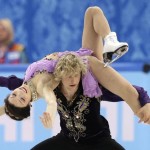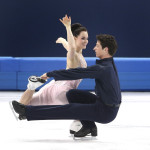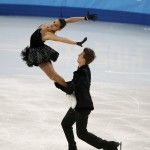VIEWPOINTS: Transcending Ice Dancing
- By drediman
- February 18, 2014
- No Comments
I’ve always found ice dancing to be an interesting beast, albeit an interesting beast with an identity crisis. It doesn’t quite have the famous bells and whistles of the other figure skating disciplines (where’s the triple axel?), and its whiplash shifts in “dance” styles between programs can be awkward. As a result, much of the time, ice dancing can come across as embarrassingly derivative, half-baked, and/or kitschy. Yesterday’s memorable Olympic ice dancing performances from the three medalists changed my mind. To commemorate yesterday’s thrilling ice dancing competition in Sochi, I’ve taken a closer look at their free dances to analyze this change of heart. The common denominator is that all three skated to music from beloved Russian ballets from the late nineteenth/early twentieth century. However, their respective interpretations of the music and underlying ballets were uniquely their own and worth investigation.
Meryl Davis & Charlie White
 The newly-crowned Olympic ice dancing champions, Americans Meryl Davis and Charlie White, skated a powerful, technically accomplished program to Russian Rimsky-Korsakov’s pulse-racing score for the ballet “Scheherazade”. Although their interpretation does not draw directly from the Diaghilev ballet tradition as much as it does from established ice dancing vocabulary, the explosiveness and creativity of this team is very much in the spirit of the Ballet Russes. What Davis and White have done is to use the exotic plot of Michel Fokine’s ballet (which premiered at the Opera Garnier in Paris in 1910) as the structure to frame their latest breathtaking ice dancing innovations. They also used the story of “Scheherazade” to inspire their striking costumes. I believe that synergy between tradition and innovation, a hallmark of the Ballet Russes, is what put Davis and White on the top of the podium.
The newly-crowned Olympic ice dancing champions, Americans Meryl Davis and Charlie White, skated a powerful, technically accomplished program to Russian Rimsky-Korsakov’s pulse-racing score for the ballet “Scheherazade”. Although their interpretation does not draw directly from the Diaghilev ballet tradition as much as it does from established ice dancing vocabulary, the explosiveness and creativity of this team is very much in the spirit of the Ballet Russes. What Davis and White have done is to use the exotic plot of Michel Fokine’s ballet (which premiered at the Opera Garnier in Paris in 1910) as the structure to frame their latest breathtaking ice dancing innovations. They also used the story of “Scheherazade” to inspire their striking costumes. I believe that synergy between tradition and innovation, a hallmark of the Ballet Russes, is what put Davis and White on the top of the podium.
Tessa Virtue & Scott Moir
 The Olympic silver medalists from Canada, Tessa Virtue and Scott Moir, also used ballet as the inspiration for their free dance. Instead of the exoticism of the Ballet Russes, this team opted to loosely base their free dance on the more stately but no less expressive ballet “The Seasons”, which was originally choreographed by Marius Petipa and beautifully scored by Alexander Glazunov (the ballet was premiered by the Imperial Ballet in 1900 in St. Petersburg). For the Olympics, Virtue and Moir looked to Glazunov’s music to take the lead in painting the picture of their free dance. Yes, the theme of this free dance still suggests the passing seasons (their program is said to chronicle the stages of their ice dancing career), but the gorgeous flowing choreography and “look” of their work is even less literally connected to the underlying ballet, or for that matter, any dance tradition, than the Americans. Their work is a personal vision, and it worked brilliantly.
The Olympic silver medalists from Canada, Tessa Virtue and Scott Moir, also used ballet as the inspiration for their free dance. Instead of the exoticism of the Ballet Russes, this team opted to loosely base their free dance on the more stately but no less expressive ballet “The Seasons”, which was originally choreographed by Marius Petipa and beautifully scored by Alexander Glazunov (the ballet was premiered by the Imperial Ballet in 1900 in St. Petersburg). For the Olympics, Virtue and Moir looked to Glazunov’s music to take the lead in painting the picture of their free dance. Yes, the theme of this free dance still suggests the passing seasons (their program is said to chronicle the stages of their ice dancing career), but the gorgeous flowing choreography and “look” of their work is even less literally connected to the underlying ballet, or for that matter, any dance tradition, than the Americans. Their work is a personal vision, and it worked brilliantly.
Elena Ilinykh & Nikita Katsalapov
 The Russian bronze medalists, Elena Ilinykh and Nikita Katsalapov, have taken the opposite approach. This young team also skated to music from a ballet, in this case Tchaikovsky’s ever-popular and iconic score from “Swan Lake” (the ballet had its premier at the Bolshoi Ballet in Moscow in 1877). However, as opposed to the two North American teams above, everything about Ilinykh and Katsalapov’s free dance cried “ballet!” To the extent afforded by being on ice with program requirements, their free dance transported the ice dancing audience to the Bolshoi to experience a dramatic performance of “Swan Lake”. Every detail, from the seductive gestures and hyper-extensions to her tutu, served to replicate the ballet experience. A lesser team would have made fools of themselves, but this young Russian team had the talent, intensity, and star power to create a thrilling and unique Olympic moment.
The Russian bronze medalists, Elena Ilinykh and Nikita Katsalapov, have taken the opposite approach. This young team also skated to music from a ballet, in this case Tchaikovsky’s ever-popular and iconic score from “Swan Lake” (the ballet had its premier at the Bolshoi Ballet in Moscow in 1877). However, as opposed to the two North American teams above, everything about Ilinykh and Katsalapov’s free dance cried “ballet!” To the extent afforded by being on ice with program requirements, their free dance transported the ice dancing audience to the Bolshoi to experience a dramatic performance of “Swan Lake”. Every detail, from the seductive gestures and hyper-extensions to her tutu, served to replicate the ballet experience. A lesser team would have made fools of themselves, but this young Russian team had the talent, intensity, and star power to create a thrilling and unique Olympic moment.

 Copyright © 2024
Copyright © 2024
Leave a Reply